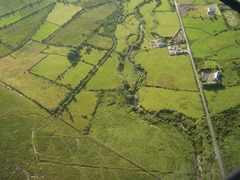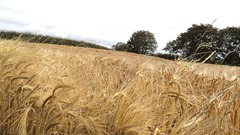‘Going for Growth’ in agri-food
 Peter Cheney summarises the Executive’s new agri-food strategy which aims to unite the different elements of the sector and significantly grow its value by 2020.
Peter Cheney summarises the Executive’s new agri-food strategy which aims to unite the different elements of the sector and significantly grow its value by 2020.
A detailed agri-food strategy for Northern Ireland has received unanimous support from the Executive parties and sets out high ambitions for the £3.7 billion sector.
The ‘Going for Growth’ plan was launched at the Balmoral Show by the First and deputy First ministers, Agriculture Minister Michelle O’Neill and Enterprise Minister Arlene Foster. The ministers expect that the plan will create 15,000 jobs if the recommendations are put into practice.
Michelle O’Neill said that a single and fully integrated supply chain (as proposed in the report) makes “sound sense” but “will require a change of mindset and behaviours so that all elements of the chain are working towards a shared goal.”
The strategy was drawn up by the Agri-Food Strategy Board which was appointed in May 2012. It contains 118 recommendations and calls for “bold decisions and continued commitment” from government. £1.3 billion of investment is sought from the industry with another £400 million coming from the Executive.
Four key targets for 2020 are set out:
• a 60 per cent growth in sales to
£7 billion;
• a 75 per cent growth in external sales to £4.5 billion;
• a 15 per cent increase in employment to over 115,000; and
• a 60 per cent increase in added value of products and services to
£1 billion.
Government and industry need to work together to identify the most efficient business models and encourage the “reinvigoration” of the industry by bringing an increased number of younger people into the agri-food workforce.
Over time, the various public bodies and interest groups in the sector would merge into four strategic organisations i.e. to encourage marketing, innovation funding, skills and entrepreneurship and to represent the interests of the industry. This suggests a merger between the Ulster Farmers’ Union and the Northern Ireland Agricultural Producers Association, which represents smaller landowners.
There is a real sense of ambition and urgency in the report. Full implementation is “critical”. This reflects the pressures caused by two of its driving factors: population growth and climate change.
The world population stands at 7.1 billion but is expected to reach 9 billion by 2050. Feeding the next generation will require a 75-90 per cent increase in global food production but climate change may reduce food yields by up to 25 per cent in the same timeframe.
Climate change could increase some local yields (due to higher temperatures) but torrential rainfall will lead to more extensive flooding and therefore damaged soils and a greater risk from pests, diseases and toxins.
The Agri-Food Strategy Board will remain in place for at least another two years to oversee progress. Its chairman, Tony O’Neill, was confident that implementing the recommendations will help to harness the “huge global opportunities” for local produce. Providing “wholesome, healthy and safe” agri-food products offered “enormous potential” as global demand increased.
Northern Ireland, though, is the last part of the British Isles to publish an agri-food strategy. Scotland did so in 2006, the Republic and Wales in 2010, and England in 2012.
The UUP welcomed the strategy’s ambition and pointed to the province’s “world renowned reputation for producing quality products.” Alliance spokesman Kieran McCarthy praised the “great tradition of a vibrant agri-food sector in Northern Ireland”.
SDLP MP Margaret Ritchie has said that agri-food should be “at the centre” of the Executive’s economic programme.
While welcoming the action plan, the Ulster Farmers’ Union (UFU) said that stark realities had to be acknowledged. UFU President Harry Sinclair explained: “Farm incomes in Northern Ireland were down an alarming 50 per cent in 2012 and primary producers as a whole actually spent £150 million in order to produce the food on our plates. The cost of production has continued to rise at a startling rate, far outstripping profit margins.”
The extra pressure of severe weather threatened the “very foundation” of the agri-food industry. However, Sinclair said that with the right support, Northern Ireland could be in “a prime position to be a top global food producing region.”
The agri-food industry is the largest part of the private sector and Secretary of State Theresa Villiers foresees it having an important role in rebalancing the economy. Speaking at the Balmoral Show, she made the case for GM foods and strong animal welfare standards. The policy areas are mentioned briefly in ‘Going for Growth’ but remain high priorities for the UK Government.
Villiers was particularly forthright on GM: “I strongly believe that this technology has huge potential to improve efficiency in food production and deliver real environmental improvements.”
High standards of animal welfare, enforced consistently across Europe, were also “vital” for the compassionate treatment of livestock and for creating a level playing field for local farmers.
Short-term: by May 2014
• Agree all-island plant health policy
• Fast track solution for poultry waste
• Remove charges for export health certificates
• Lobby Treasury for 300 per cent capital allowances for investments
Medium-term: by May 2015
• Single marketing body for Northern Ireland produce
• Single innovation and skills/entrepreneurship bodies
• Alcohol licensing review to create “level playing field” with Britain
• Roll out Land and Buildings Improvement Scheme (beef and sheep sectors)
Long-term: up to 2020
• Double draw-down of EU funding for innovation and skills (by 2016)
• Fully fund £250 million Farm Business Improvement Scheme (by 2016)
• Draw up strategic regional land management policy
• Consider GCSE training to prepare young people for agri-food careers






